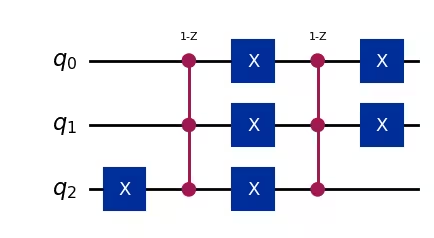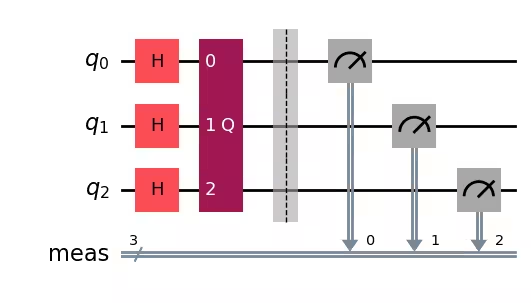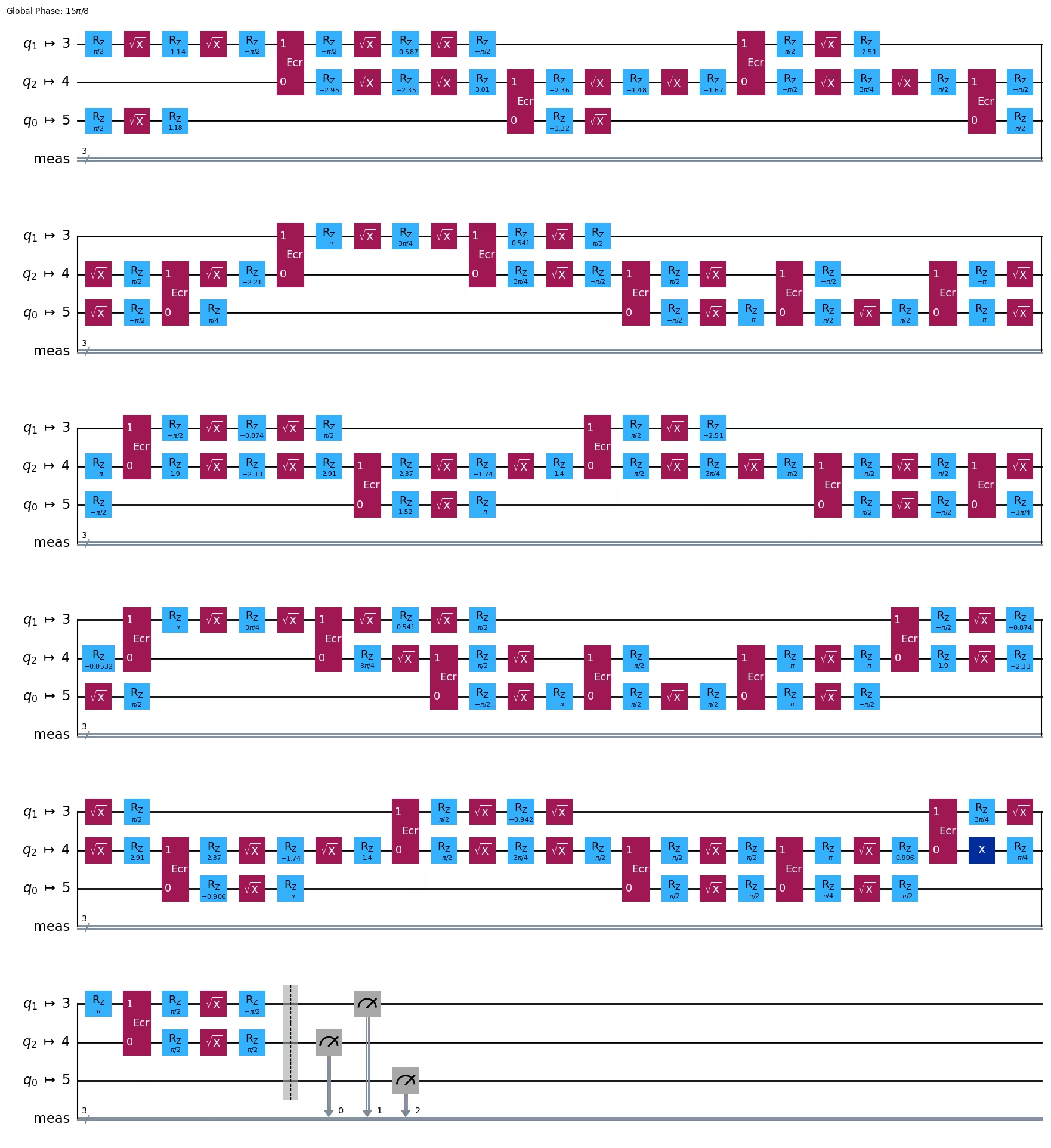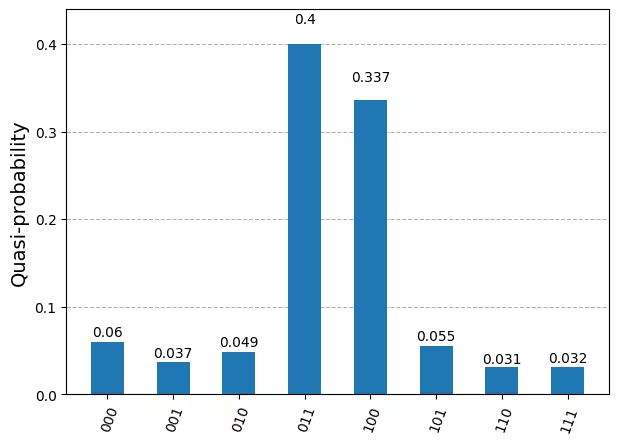Grover's algorithm
Usage estimate: under 1 minute on IBM Nairobi (NOTE: This is an estimate only. Your runtime may vary.)
Background
Amplitude amplification is a general purpose quantum algorithm, or subroutine, that can be used to obtain a quadratic speedup over a handful of classical algorithms. Grover’s algorithm was the first to demonstrate this speedup on unstructured search problems. Formulating a Grover's search problem requires an oracle function that marks one or more computational basis states as the states we are interested in finding, and an amplification circuit that increases the amplitude of marked states, consequently suppressing the remaining states.
Here, we demonstrate how to construct Grover oracles and use the grover_operator() from the Qiskit circuit library to easily set up a Grover's search instance. The runtime Sampler primitive allows seamless execution of Grover circuits.
Requirements
Before starting this tutorial, ensure that you have the following installed:
- Qiskit SDK 1.4 or later, with visualization support (
pip install 'qiskit[visualization]') - Qiskit Runtime (
pip install qiskit-ibm-runtime) 0.36 or later
Setup
# Built-in modules
import math
# Imports from Qiskit
from qiskit import QuantumCircuit
from qiskit.circuit.library import grover_operator, MCMTGate, ZGate
from qiskit.visualization import plot_distribution
from qiskit.transpiler.preset_passmanagers import generate_preset_pass_manager
# Imports from Qiskit Runtime
from qiskit_ibm_runtime import QiskitRuntimeService
from qiskit_ibm_runtime import SamplerV2 as Sampler
def grover_oracle(marked_states):
"""Build a Grover oracle for multiple marked states
Here we assume all input marked states have the same number of bits
Parameters:
marked_states (str or list): Marked states of oracle
Returns:
QuantumCircuit: Quantum circuit representing Grover oracle
"""
if not isinstance(marked_states, list):
marked_states = [marked_states]
# Compute the number of qubits in circuit
num_qubits = len(marked_states[0])
qc = QuantumCircuit(num_qubits)
# Mark each target state in the input list
for target in marked_states:
# Flip target bit-string to match Qiskit bit-ordering
rev_target = target[::-1]
# Find the indices of all the '0' elements in bit-string
zero_inds = [
ind
for ind in range(num_qubits)
if rev_target.startswith("0", ind)
]
# Add a multi-controlled Z-gate with pre- and post-applied X-gates (open-controls)
# where the target bit-string has a '0' entry
qc.x(zero_inds)
qc.compose(MCMTGate(ZGate(), num_qubits - 1, 1), inplace=True)
qc.x(zero_inds)
return qcStep 1: Map classical inputs to a quantum problem
Grover's algorithm requires an oracle that specifies one or more marked computational basis states, where "marked" means a state with a phase of -1. A controlled-Z gate, or its multi-controlled generalization over qubits, marks the state ('1'* bit-string). Marking basis states with one or more '0' in the binary representation requires applying X-gates on the corresponding qubits before and after the controlled-Z gate; equivalent to having an open-control on that qubit. In the following code, we define an oracle that does just that, marking one or more input basis states defined through their bit-string representation. The MCMT gate is used to implement the multi-controlled Z-gate.
# To run on hardware, select the backend with the fewest number of jobs in the queue
service = QiskitRuntimeService()
backend = service.least_busy(
operational=True, simulator=False, min_num_qubits=127
)
backend.nameOutput:
'ibm_cusco'
Specific Grover's instance
Now that we have the oracle function, we can define a specific instance of Grover search. In this example we will mark two computational states out of the eight available in a three-qubit computational space:
marked_states = ["011", "100"]
oracle = grover_oracle(marked_states)
oracle.draw(output="mpl", style="iqp")Output:

Grover operator
The built-in Qiskit grover_operator() takes an oracle circuit and returns a circuit that is composed of the oracle circuit itself and a circuit that amplifies the states marked by the oracle. Here, we use the decompose() method the circuit to see the gates within the operator:
grover_op = grover_operator(oracle)
grover_op.decompose().draw(output="mpl", style="iqp")Output:

Repeated applications of this grover_op circuit amplify the marked states, making them the most probable bit-strings in the output distribution from the circuit. There is an optimal number of such applications that is determined by the ratio of marked states to total number of possible computational states:
optimal_num_iterations = math.floor(
math.pi
/ (4 * math.asin(math.sqrt(len(marked_states) / 2**grover_op.num_qubits)))
)Full Grover circuit
A complete Grover experiment starts with a Hadamard gate on each qubit; creating an even superposition of all computational basis states, followed the Grover operator (grover_op) repeated the optimal number of times. Here we make use of the QuantumCircuit.power(INT) method to repeatedly apply the Grover operator.
qc = QuantumCircuit(grover_op.num_qubits)
# Create even superposition of all basis states
qc.h(range(grover_op.num_qubits))
# Apply Grover operator the optimal number of times
qc.compose(grover_op.power(optimal_num_iterations), inplace=True)
# Measure all qubits
qc.measure_all()
qc.draw(output="mpl", style="iqp")Output:

Step 2: Optimize problem for quantum hardware execution
target = backend.target
pm = generate_preset_pass_manager(target=target, optimization_level=3)
circuit_isa = pm.run(qc)
circuit_isa.draw(output="mpl", idle_wires=False, style="iqp")Output:

Step 3: Execute using Qiskit primitives
Amplitude amplification is a sampling problem that is suitable for execution with the Sampler runtime primitive.
Note that the run() method of Qiskit Runtime SamplerV2 takes an iterable of primitive unified blocks (PUBs). For sampler, each PUB is an iterable in the format (circuit, parameter_values). However, at a minimum, it takes a list of quantum circuit(s).
# To run on local simulator:
# 1. Use the StatevectorSampler from qiskit.primitives instead
sampler = Sampler(mode=backend)
sampler.options.default_shots = 10_000
result = sampler.run([circuit_isa]).result()
dist = result[0].data.meas.get_counts()Step 4: Post-process and return result in desired classical format
plot_distribution(dist)Output:

Tutorial survey
Please take one minute to provide feedback on this tutorial. Your insights will help us improve our content offerings and user experience.
© IBM Corp. 2023